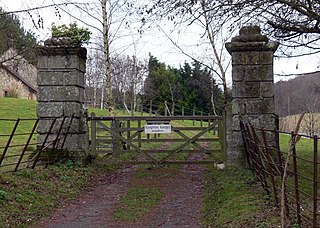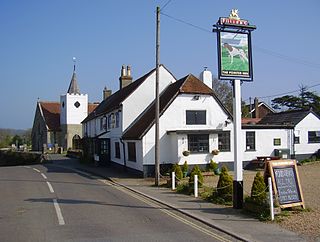
Shalden is a village and civil parish in the East Hampshire district of Hampshire, England. It is 2.3 miles (3.7 km) northwest of Alton and 1.9 miles (3.1 km) northeast of Bentworth, just off the A339 road. The parish covers an area of 1,536 acres (622 ha) and has an average elevation of 600 feet (180 m) above sea level. The nearest railway station is Alton, 2.5 miles (4.0 km) southeast of the village. According to the 2011 census, it had a population of 435.

The Great Budbridge Manor is a manor house just south of Merstone, near Arreton, Isle of Wight, England. Fish ponds on the grounds appear medieval.

Knighton Gorges Manor was one of the grandest manor houses on the Isle of Wight. Located in the hamlet of Knighton, near Newchurch, it is reported to be one of the most haunted locations on the Isle of Wight.
Ashey Manor is a manor house in Ashey on the Isle of Wight, situated within the Newchurch parish. It was historically linked with Ryde Manor.
Ryde Manor is a manor house in Ryde on the Isle of Wight, situated within the Newchurch parish. It was historically linked with Ashey Manor.
Cleaveland Manor is a manor house on the Isle of Wight, situated within the Victoria parish.
Smallbrook Manor is a manor house on the Isle of Wight, lying at the north-eastern boundary of Newchurch parish. It doubtless took its name from the stream that here forms the boundary of the parish. It is of ancient origin, as in 1280 William de Smallbrook (Smalebrook) granted land to his son Hugh. It was held at the end of the 14th century by the Wyvill family, and remained in their possession until 1491–2, when Stephen Wyvill, the last of the family, sold it to Henry Howles. Smallbrook passed in the Howles family until the reign of Elizabeth, when it was divided between co-heirs and sold to Sir William Oglander. In the court held at Ashey Manor, 1 November 1624, Sir John Oglander was returned as a freeholder and free suitor of the manor for his farm called 'Smallbroke.' The estate has since descended with Nunwell and as of 1912 was held by Mr J. H. Oglander, who had the Court Rolls in his possession.
Wroxall Manor was a manor house on the Isle of Wight, situated in the Newchurch parish.

Wolverton Manor is a manor house in Shorwell, on the Isle of Wight, England. The original house was started by John Dingley, Deputy Governor of the Isle of Wight. The Jacobean style home, built by Sir John Hammond after the death of Sir John Dingley, is the second house built on the site. There is a two-storey porch which features a flat roof and hollow angle columns.
Hale Manor is a manor house on the Isle of Wight, situated in the parish of Arreton. It forms the south-eastern portion of the parish adjoining Newchurch, and comprises the high ground to the south of the River Yar above Horringford.
Horringford Manor is a manor house on the Isle of Wight, situated in the parish of Arreton.
Rookley Manor is a manor house on the Isle of Wight, situated in the parish of Arreton. Though originally in Godshill parish, it is now included for the greater part in the boundaries of South Arreton.
Alverstone Manor is a manor house in Alverstone in the parish of Brading on the Isle of Wight.
Barnsley Manor is a manor house in the parish of Brading on the Isle of Wight.
Milton Manor is a manor house in the parish of Brading on the Isle of Wight, in England.

From AD 1066, the feudal barony of Barnstaple was a large feudal barony with its caput at the town of Barnstaple in north Devon, England. It was one of eight feudal baronies in Devonshire which existed in the Middle Ages. In 1236 it comprised 56 knight's fees or individual member manors. The feudal service owed for half the barony in 1274 was the provision to the royal army of two knights or four sergeants for forty days per annum, later commuted to scutage.

Whitechapel is an ancient former manor within the parish of Bishops Nympton, in north Devon. It was the earliest known residence of the locally influential Bassett family until 1603. The core of the present manor house is late 16th or early 17th century, with later additions and alterations, and was classed as Grade I listed on 9 June 1952.

The historic manor of Raleigh, near Barnstaple and in the parish of Pilton, North Devon, was the first recorded home in the 14th century of the influential Chichester family of Devon. It was recorded in the Doomsday Book of 1086 together with three other manors which lay within the later created parish of Pilton. Pilton as a borough had existed long before the Norman Conquest and was one of the most important defensive towns in Devon under the Anglo-Saxons. The manor lies above the River Yeo on the southern slope of the hill on top of which exists the ruins of the Anglo-Saxon hillfort of Roborough. The historic manor of Raleigh is now the site of the North Devon District Hospital.

The Manor of King's Nympton was a manor largely co-terminous with the parish of King's Nympton in Devon, England.

The Manor of Totteridge was located in Totteridge, Hertfordshire, in an area that is now part of the London Borough of Barnet. The manor was historically associated with the Manor of Hatfield. The original manor house was demolished before 1821 and the manorial estate known as Totteridge Common was transferred to a charity, the Totteridge Manor Association, in 1954.













